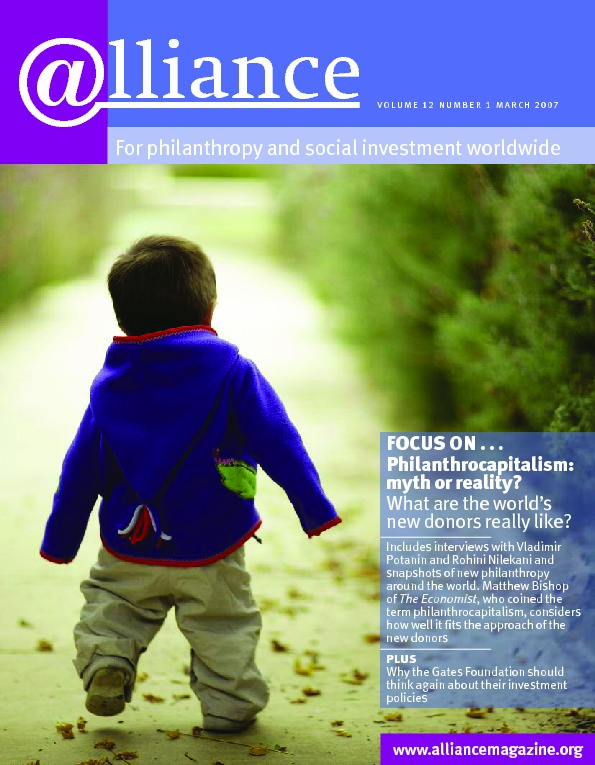Over the last 30 or so years Brazil’s population has more than doubled from 90 million in 1970 to over 186 million in 2006. While stable but slow economic growth has permitted some social advances, such as school access for 97 per cent of the population, Brazil remains a highly unequal society, ranked tenth out of 126 countries in terms of unequal wealth distribution (UNDP, 2006). What role is Brazil’s new generation of philanthropists playing in rectifying these inequalities?
Three models for individual donors
In Brazil today, individual donors can contribute in three different ways: by setting up grantmaking foundations; by creating organizations that provide services; and by contributing to the corporate foundations of the companies in which they hold shares.
The first model is the least common. Private grantmaking foundations created to channel individuals’ wealth in support of social causes are comparatively rare, owing to a lack of fiscal incentives, trust and professionalism, or a combination of these. One example is a grantmaking organization set up in 2001 by the parents and siblings of a young victim of a sudden aneurism, who decided to come together to set up a new organization dedicated to supporting people with disabilities.
Brazilian donors have more often provided seed funding to service-providing organizations which also obtain funds from other sources. Many key organizations in the areas of health and education were created in this way. Examples include ACTC, which supports low-income heart-transplanted children and their families through treatment; AACD, a model organization that supports children with physical disabilities; and the Ayrton Senna Foundation, created by the car racing driver’s family after Ayrton’s death in 1994 and dedicated to create and disseminate education technology.
The third channel for private social investment is through stimulating increased company giving. Rather than setting up their own foundations, many shareholders in Brazilian companies make donations to company foundations, recognizing that their own private social investment can be leveraged n-fold if their companies are mobilized, providing in-kind donations, knowledge, brand and employee engagement as well as cash. The shareholder’s role is often to lead this internal change – creating ‘sustainable capitalism’, as one shareholder of the Camargo Corrêa Group put it. Some examples include Camargo Corrêa, Votorantim and Gerdau Institutes, all created within the last six years, and Boticário Foundation, which has a shareholders’ resolution that 1 per cent of company annual profit be allocated as the foundation’s budget.
A new generation
An innovative programme directed at a new generation of young wealthy people aged 25-35 was created last year. It was co-funded by a group of social investors, some as young as 24. The 20-strong group participated in a year’s programme that aimed to stimulate and educate social investment in Brazil by helping participants better understand the divide between rich and poor. Activities included studying the history of Brazilian society, talking to key social leaders and visiting social development projects.
Members of the group identified alternative ways of practising social investment, all with strong entrepreneurial characteristics. One member induced the shareholders of his investment company to create a social investment committee to support public education; another encouraged the creation of a giving circle; another focused family giving in support of child development.
Planning for change, not hoping for it
A new generation of wealthy Brazilians is emerging who understand the need for social change and are willing to contribute towards it. Do Brazil’s new social investors fit Matthew Bishop’s definition of ‘philanthrocapitalism’ as hands-on, results-oriented and applying business skills?
The answer has to be yes. Those at the forefront are dedicating time and money to learn more about the field and about how to achieve social change. All of them have a keen eye on the results obtained and the changes made with and through community participation, so planning, monitoring and evaluating projects is key to the private social investment concept. In fact, it’s one of the key differences between this practice and the traditional charitable donation. But the most significant thing about these new donors is that they see their role as helping to achieve social change in their country.
Carla Duprat is Social Investment Director at PMV. Email carla.duprat@camargocorrea.com.br






Comments (0)